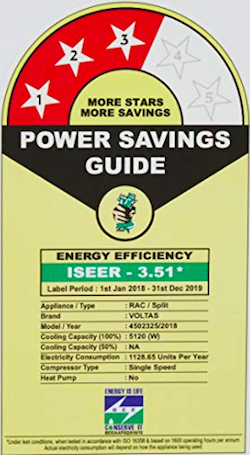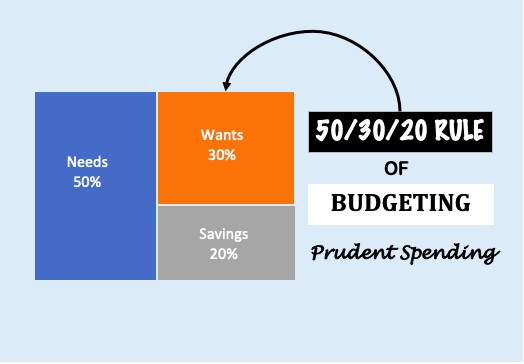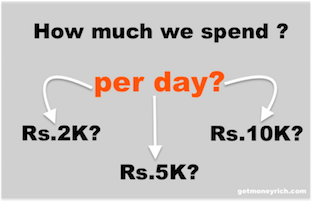Why it is important to plan purchase of air conditioner (AC) for home?
One time cost of a typical 1.5T AC is not so high. It will cost around Rs.30,000.
Though it is not cheap, but still people do manage to afford it.
But the actual expense of an air conditioner is its operating & maintenance cost.
What is the expected monthly electricity bill of a typical 2 BHK apartment?
- Without AC: Rs.1,000 per month.
- With AC: Rs.2,500 per month (per AC).
- With AC: Rs.4,500 per month (per 2 AC).
There is a jump of 150-200% in electricity consumption due to AC usage.
Our AC’s has become almost mandatory in our lives. But we must not forget that an AC is a liability.
A bad AC’s purchase can really hurt ones pocket.
Hence it is only prudent to approach the purchase of AC with a right planning.
#1. Air Conditioners has become a necessity.
In cities like Delhi, Mumbai, Kolkata, Chennai, life in summer without Air Conditioner is unimaginable.
With temperatures soaring almost 2-3 Degrees in last decade, usage of AC has become almost a necessity.
This is true for all of north India, where temperature easily cross 40 Degree Celcius in summers.
But the problem with AC is its high cost.
- Cost of purchase.
- Cost of operation and maintenance.
Hence it is only reasonable to plan purchase of an air conditioner for home.
What needs to be planned?
- Size of air conditioner (AC) required.
- Optimum energy efficiency required.
But before we see the planning part, lets become aware of few common mistakes that people do in AC purchase.
This awareness will further reinstate the necessity of planning AC purchase before spending a dime.
#2. Common mistakes in air conditioner’s purchase
Before we go into the details of how to plan purchase of air conditioner, lets learn about common mistakes first.
These common mistakes people do while purchasing AC’s.
How we generally buy an AC?
In heat of one summer day, the family decides that enough is enough. Now we cannot live without an AC.
So what is the next step? We ask few basic questions like:
- Which rooms need air conditioning?
- Window or split AC?
- What will be the Budget?
- Size of AC: 1T, 1.5T, or 2T?
- Make of AC?
- Where to buy?
Does it sound familiar? I am sure, most of us bought our AC like this.
This type of planning is enough? In most cases, these steps work.
But for some, the shoe starts to bite immediately after the first walk.
This is when the mistake is realised and people regret.
The biggest realisation of mistake is felt when the electricity bill soars sky high (80% more).
So this brings us to our first mistakes we make while buying an air conditioner.
#2.1 Mistake: Unprepared for spike in recurring expenses.
Yes, people prepare themselves to buy an air conditioner which will cost Rs.30K.
But they do not prepare themselves for the extra recurring expenses.
What are the recurring expenses?
- High electricity bill.
- Annual Maintenance cost.
Being prepared for these recurring expenses should be the part of planning, that goes in purchasing an air conditioner.
Best is to budget as following:
- Keep aside 50% extra per month for spike in electricity bills (for all 12 months).
- Keep aside a lump-sum Rs.2,000 for annual AC maintenance.
Annual maintenance will cover cleaning, coolant change, electrical repairs etc.
In the initial years, AC maintenance cost will be lower. But henceforth, Rs.2K will be necessary every year.
#2.2 Mistake: Buying an AC which is either too small or too big.
In both the cases, the electricity consumption will be high.
If AC is sized incorrectly, two things can happen:
- It will put extra load on the compressor, which is bad for its health
- It also draws more electricity, means more expense.
One can use simple thumb-rules to estimate the optimum size of AC for a room. It is easy, and any one can do it with ease.
We will see in this blog post (#3.1), how to estimate size of an ac.
#2.3 Mistake: Buying an AC which is cheapest
Which AC is cheapest? One which has smallest one-time cost.
People often fall prey to the up-front cost factor associated with purchasing an AC.
Let me give you an example.
Last time when I searched Amazon for 1.5T, Split AC, it showed results of 85 nos different AC’s.
The price range for the entire 85 nos AC were as below:
- Minimum: Rs.23,000
- Maximum: Rs.62,000.
The price range is huge.
If you fall under the influence of a clever salesman, he might judge you, and convince you to buy the cheapest AC available on display.
But is it the right way to buy the AC? The answer is No. Why?
The answer is somewhere hidden in the below image.

Ok, perfect. I am sure most of us are aware what this picture is, right?
The star rating (1 to 5), tells us how energy efficient is the Air Conditioner.
Star 1 means least efficient, Star 5 means most efficient.
So does it means that everyone should buy a 5 star rated AC. Not necessary. Why?
Of course 5 star rated AC’s are costlier. But more than its cost, 5 star rated AC is not for everyone. How?
We will see in this blog post (#4.0), how to evaluate which star rating is more suitable for self.
But before that, lets see an example related to star ratings of AC’s:
Suppose, ones budget is Rs.29,000-30,000.
Out of the 85 nos AC that is displayed by Amazon, the price range and star rating of AC’s has been summarised as below:
| Star Rating | Price (min) Rs. | Price (max) Rs. | Nos of AC on Display |
| 1 | 25,990 | 35,621 | 7 Nos. |
| 2 | 22,999 | 42,990 | 5 Nos. |
| 3 | 24,990 | 51,999 | 63 Nos. |
| 4 | 35490 | 3990 | 2 Nos. |
| 5 | 35990 | 62100 | 8 Nos. |
| 85 Nos |
So from the above table, you can see that, within the Budget of Rs.30K, following AC’s were available:
- 1 Star.
- 2 Star.
- 3 Star.
I am sure, people will get more confused with this.
An air condition with only 1 star rating, has a similar price as that of a 3 star AC? How it is possible.
It is not possible.
Buying AC based on price and star rating alone is not enough.
As a buyer, we must learn to read deeper into the “Star Rating Guide” provided along with the AC.
#2.4 Mistake: Buying AC based on old star rating label.
For year 2018-2019, a new star rating label is applicable.
The star rating parameters have become more stringent now. Example:
- Earlier 5 star rating AC’s are now 3 Star.
- Earlier 3 star rating AC’s are now 1 Star.
It is very important for buyers to check if the displayed star rating is as per latest norms or not.
The latest Star Rating Label as per ISEER Ratings will have validity dates displayed as shown below:

#3. Decide the requirement of the AC.
Deciding requirement means:
- Estimating the right size of AC.
- Finalising the requirement of “Star Rating”.
In #2 what we have learnt?
We have learnt to avoid the common mistakes that is encountered while buying AC’s.
Before one fix the requirement following realisations with the buyer is essential:
- AC installation will increase the electricity consumption.
- 1.5T AC is better than 1.0T AC is not always a correct understanding.
- Cheapest AC is not always the best.
- Always buy AC based on latest Star Ratings.
Once the person has realised the above, the next step is to do some math related to AC sizing etc.
#3.1 Decide the Size of AC Required for a Room
Split Air conditioners are available in market in following sizes:
- 0.8T
- 1.0T
- 1.2T
- 1.5T
- 2.0T
What means by Tonnes in AC sizing? Amount of heat removed by the AC in one hour.
The bigger will be the AC, more will be the heat removed.
| SL | Size | Heat Removed (Cooling Capacity) | Heat Removed (Cooling Capacity) |
| 1 | 0.8T | 9,600 BTU/HR | 2,813 KW |
| 2 | 1.0T | 12,000 BTU/HR | 3,517 KW |
| 3 | 1.2T | 14,400 BTU/HR | 4,130 KW |
| 4 | 1.5T | 18,000 BTU/HR | 5,275 KW |
| 5 | 2.0T | 24,000 BTU/HR | 7,033 KW |
So, depending on the size and configuration of the room, a suitable sized AC must be selected.
A correlation must be established between the room size and AC size.
How to do it?
Step #1: Calculate the floor area of the room.
- Length of Room (L): 3.4 meter.
- Width of Room (W): 3.1 meter.
Floor area of the room will be:
Floor Area = L X W = 3.4 x 3.1 = 10.5 SQM.
Step #2: Estimate the heat load of the room.
The bigger is the room, more will be its heat load.
More heat loan means, bigger size AC will be required to cool it.
The heat load of the room could be decided from the below table:
| Area (SQM) | Area (SQFT) | Heat Load in BTU/HR |
| 9.29 – 13.84 | 100-149 | 7,800 |
| 14 – 23.13 | 150-249 | 10,200 |
| 23.22 – 27.77 | 250-299 | 16,200 |
| 27.87 – 37.06 | 300-399 | 12,600 |
| 37.16 | 400 | 22,200 |
What does this table assume?
- Standard height of room: 2.7m.
- Occupancy in room: 2 people.
- Windows: 2 Nos of Standard size.
- Sun Exposure: Moderate.
How to read this table?
Suppose the floor area of your room is as below:
Floor Area = L X W = 3.4 x 3.1 = 10.5 SQM.
This size of room will have a heat load of 7,800 BTU/HR.
Step #3: Consider additional heat load of the room.
In Step #2 above, the heat load of the room was estimated based on the size of the room.
But there could be other factors, which might increase the heat load of the room.
Lets see some such typical factors:
| Factors | Effect on Heat Load of Room |
| Room remains exposed to sunlight for prolonged period of time | Add 10% |
| If more than 2 people live in the room | Add 600 BTU/HR/PERSON |
| IF the AC will operate only in the night time (low ambient) | Subtract 10% |
| If the Room includes the kitchen space | Add 7,000 BTU/HR |
In our example, let’s assume that the room is exposed to sunlight for a prolonged duration.
Hence the estimated heat load must be increased by 10%.
Additional heat load will be: 10% of 7,800 = 780 BTU/HR
Step #4: Estimate the size of AC
- Heat Load based on size – 7,800 BTU/HR
- Heat Load based on other factors – 780 BTU/HR
- Total Heat Load of Room – 8,580 BTU/HR
Use the BTU/HR to TONNE conversion factor.
12,000 BTU/HR = 1T
8,580 BTU/HR = 0.715T
Approximate size of Air Conditioner that should be suitable for this room is 0.715T.
But in market 0.715T AC will not be available.
The nearest size available will be 0.8T (see #3.1 above).
#3.2 Learn to Read the Star Ratings.
In the last few years, India has adopted a new Star Rating Methodology.
It is called as Indian Seasonal Energy Efficiency Ratio (ISEER).
Compared to the earlier rating methodology, ISEER is more stringent.
The higher is the ISEER (ratio), means better is the efficiency of the Air Conditioner.
ISEER = Heat Removed per hour / Power Consumed per hour.
As per the new rating methodology, following ISEER values will be subjected to these star ratings:
| Star Rating | ISEER (MIN) | ISEER (MAX) |
| 1 | 3.10 | 3.29 |
| 2 | 3.30 | 3.49 |
| 3 | 3.50 | 3.99 |
| 4 | 4.00 | 4.49 |
| 5 | 4.50 |
What does the table suggest?
- AC with ISEER 3.52 will have a Star Rating of 3.
- AC with ISEER 3.92 will also have a Star Rating of 3.
But it does not means that both these air conditioners are same.
ISEER 3.92 AC is more efficient.
For the same ambient conditions, it will consume less power that ISEER 3.52 AC.
#4. Which Air conditioner is more cost effective.
After all these knowledge gathering, let’s try to answer this core question.
What means by “cost effectiveness” in terms of AC’s?
Air Conditioner has costs associated with it:
- Purchase cost (PC).
- Operation cost (OC).
- Maintenance cost (MC).
The AC’s which has a minimum cumulative cost (PC+OC+MC) can be tagged as cost effective.
How to do this math? Lets start with the obvious one.
#4.1 Cost Effectiveness (8 Hours Operation)
To do this calculation we will have to first make few assumptions:
- Daily Run-time of AC: 8 hours/day.
- Monthly Run-time of AC: 30 Days/Month.
- Annual Run-time of AC: 6 Months / year.
- Size of AC: 1.5T.
- Type: Split
- Cooling Capacity: 5118 KW
- Life of AC: 5 Years
Typical Calculation for a 2 & 5 Star AC is shown below:
| Description | (Unit) | AC-2 (1.5T) | AC-2 (1.5T) |
| ISEER | – | 3.3 | 4.5 |
| STAR | – | 2 | 5 |
| Cooling Capacity (1.5T) | KW | 5.275 | 5.275 |
| Power Consumed | KW/HR | 1.598 | 1.172 |
| Power Consumer Per Day | KWH | 12.79 | 9.38 |
| Power Consumer Per Month | KWH | 383.64 | 281.33 |
| Power Consumer Per Year | KWH | 2,301.82 | 1,688.00 |
| Power Consumer in 5 Years | KWH | 11,509.09 | 8,440.00 |
| Power Consumer in 5 Years | Units | 11,509.09 | 8,440.00 |
| Electricity Rate | Rs./Unit | 6.6 | 6.6 |
| Operating Cost in 5 Years | Rs. | 75,960 | 55,704 |
| Maintenance Cost @Rs.1500/year | Rs. | 7,500 | 7,500 |
| One Time Cost of Purchase | Rs. | 32,990 | 51,200 |
| Total Cost in 5 Year | Rs. | 1,16,450 | 1,14,404 |
A similar calculation was done for all Star Ratings. The result is as below:
- 1 Star – Rs.1,18,761 (Total cost in 5 years)
- 2 Star – Rs.1,16,450 (Total cost in 5 years)
- 3 Star – Rs.1,26,450 (Total cost in 5 years)
- 4 Star – Rs.1,18,167 (Total cost in 5 years)
- 5 Star – Rs.1,14,404 (Total cost in 5 years)
What we can conclude? For @8 hours running per day:
5 Star and 2 Star AC’s look more economical.
But in terms of cost of purchase only, one will have to pay Rs.18,210 more upfront to buy 5 star AC compared to 2 star.
Hence, if I am the purchaser, 2 star AC will work fine for me.
#4.1 Cost Effectiveness (12 Hours Operation)
To do this calculation we will have to first make few assumptions:
- Daily Run-time of AC: 12 hours/day.
- Monthly Run-time of AC: 30 Days/Month.
- Annual Run-time of AC: 6 Months / year.
- Size of AC: 1.5T.
- Type: Split
- Cooling Capacity: 5118 KW
- Life of AC: 5 Years
Typical Calculation for a 4 & 5 Star AC is shown below:
| Description | AC-2 (1.5T) | AC-2 (1.5T) | |
| ISEER | – | 4 | 4.5 |
| STAR | – | 4 | 5 |
| Cooling Capacity (1.5T) | KW | 5.275 | 5.275 |
| Power Consumed | KW/HR | 1.319 | 1.172 |
| Power Consumer Per Day | KWH | 15.83 | 14.07 |
| Power Consumer Per Month | KWH | 474.75 | 422 |
| Power Consumer Per Year | KWH | 2,848.50 | 2,532.00 |
| Power Consumer in 5 Years | KWH | 14,242.50 | 12,660.00 |
| Power Consumer in 5 Years | Units | 14,242.50 | 12,660.00 |
| Electricity Rate | Rs./Unit | 6.6 | 6.6 |
| Operating Cost in 5 Years | Rs. | 94,001 | 83,556 |
| Maintenance Cost @Rs.1500/year | Rs. | 7,500 | 7,500 |
| One Time Cost of Purchase | Rs. | 48,000 | 51,200 |
| Total Cost in 5 Year | Rs. | 1,49,501 | 1,42,256 |
A similar calculation was done for all Star Ratings. The result is as below:
- 1 Star – Rs.1,59,191 (Total cost in 5 years)
- 2 Star – Rs.1,54,430 (Total cost in 5 years)
- 3 Star – Rs.1,61,829 (Total cost in 5 years)
- 4 Star – Rs.1,49,501 (Total cost in 5 years)
- 5 Star – Rs.1,42,256 (Total cost in 5 years)
What we can conclude? For @12 hours running per day:
The higher is the star rating, more is the cost effectiveness.
5 Star and 4 Star AC’s look more economical.
In terms of cost of purchase only, one will have to pay just Rs.3,200 more upfront to buy 5 star AC compared to 4 star.
Hence, if I am the purchaser, 5 star AC will work fine for me.
Conclusion
Buying air conditioners for our home is a common activity.
But it is better to plan purchase of air conditioner, and then spend money. Why?
Because an air conditioner is a liability which has high recurring expenses. Moreover, upfront cost of AC’s are also not cheap.
How to plan purchase of air conditioner has been explained in this article.
Two things that is worth reading in this article about AC’s:
- How to size air conditioner?
- Which star rating is most suitable?
Star rating of AC’s are something which people often misinterpret while buying.
As a general one, remember this:
- If the usage of AC is low, 2 or 3 star AC’s should be enough.
- If the usage of AC is high, go for a 5 star AC.
- If two AC’s have same star rating, go with one having higher ISEER.
It is also worth noting that, 3 star AC’s are the most sold AC’s of the market. Hence, their cost effectiveness is generally lower.




